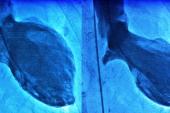Most Takotsubo Patients Die From CV Causes, but Standard Meds No Help
There remains an unmet need for therapies proven to lower the increased CV risk seen in this population.

Patients with Takotsubo syndrome are most likely to die from a cardiovascular cause over the long term, with an overall mortality risk approaching that of patients who have had an acute MI, according to findings from a national Scottish registry.
Disconcertingly, medications for cardiovascular prevention proven to have benefits in the post-MI setting did not appear to lessen mortality in patients who had experienced Takotsubo syndrome.
“Therefore, we probably need to look in the future at something which is far more personalized to this particular condition, targeted to the pathophysiology of Takotsubo itself rather than extrapolated from another condition,” senior investigator Dana Dawson, DM, DPhil (University of Aberdeen and NHS Grampian, Scotland), told TCTMD. “We need to do more work. We need to find out what really helps these patients in the long term.”
The findings were published online this week in JACC: Advances, with lead author Amelia Rudd, MSc (University of Aberdeen and NHS Grampian).
The Scottish Takotsubo Registry
There are no established, evidence-based treatments for takotsubo syndrome, also known as broken heart syndrome or “stress cardiomyopathy.” Takotsubo presents in a similar fashion to acute MI, and had—until recently—been perceived as typically self-limiting and relatively benign. Due to the lack of evidence to guide physicians, management of these patients varies widely in practice.
To explore long-term outcomes, causes of death, and medication use in this population, the investigators turned to the Scottish Takotsubo Registry, the first national cohort captured, according to Dawson, who said the data are thus more robust than those from prior studies using more selected populations. Linkage to electronic health records from Public Health Scotland also allowed the researchers to track prescriptions throughout the follow-up period.
The current analysis included 620 patients with Takotsubo syndrome recorded between 2010 and 2017. These patients were matched 1:4 by age, sex, and geography to 2,480 individuals from the general population of Scotland and 1:1 by age and sex to 620 patients with acute MI from the High-STEACS trial database. Overall, the mean age of the patients was 66 years, and 91% were women.
During a median follow-up of 5.5 years, 25% of patients with Takotsubo syndrome died, a rate higher than that seen in the general population (15%) but similar to that seen in patients who had had an acute MI (31%). After adjustment, the Takotsubo patients had greater risks of CV mortality (HR 2.47; 95% CI 1.81-3.39) and noncardiovascular death (HR 1.48; 95% CI 1.16-1.87) than did the general population. Compared with patients who had had an acute MI, they had a lower risk of CV death (HR 0.61; 95% CI 0.44-0.84) but a similar risk of noncardiovascular mortality (HR 0.92; 95% CI 0.69-1.23).
“The cardiovascular mortality in patients with Takotsubo syndrome was mostly due to heart failure causes,” the authors write. “Indeed, we have previously demonstrated that after the ‘recovery’ from the acute episode, a proportion of patients evolve toward a heart failure with preserved ejection fraction phenotype in the longer term.”
The investigators also assessed the use and impact of various medications, including those used to treat CVD, such as ACE inhibitors/ARBs, beta-blockers, antiplatelets, statins, and diuretics, and others, such as steroids, nonsteroidal anti-inflammatory drugs, psychotropic medications, hormone replacement therapy, and thyroxine therapy.
Use of CV medications was similar in patients with Takotsubo syndrome and in those who had had an acute MI. “We were quite surprised” by this finding, Dawson said, citing the lack of clinical trials evaluating these drugs in patients with Takotsubo.
Though the CV medications were associated with lower mortality risks in patients who’d had an acute MI, as expected, none were associated with a benefit in the setting of Takotsubo syndrome in an analysis confined to prescriptions that covered most of the follow-up period. Diuretics, along with anti-inflammatory drugs and psychotropic medications, in fact were associated with worse outcomes, both in patients with Takotsubo syndrome and in those who had had an MI.
“Thus, the effects of modern cardiovascular therapies on survival in patients with Takotsubo syndrome are unclear and require prospective evaluation in randomized controlled trials,” the researchers write. “Overall, it appears that the search for appropriate lifesaving medication after Takotsubo syndrome is only beginning and has yet to be realized.”
A Call for Tailored Therapy
Commenting for TCTMD, Rodolfo Citro, MD, PhD (San Giovanni di Dio e Ruggi d’Aragona University Hospital, Salerno, Italy), lead author of an accompanying editorial, said the most noteworthy information to come from the study involves the causes of death, which previously had not been well described. The findings confirm that patients with Takotsubo syndrome have a greater risk of dying compared with the general population, and only a slightly lower risk compared with patients who have had an MI.
When it comes to determining the impact of various medications in the setting of Takotsubo syndrome, the study has some limitations, Citro said, pointing to the risks of exposure misclassification and selection bias that can influence between-group comparisons. Thus, the results cannot be considered conclusive, “and probably therapy should be tailored according to the coexisting comorbidities and the comorbidity burden of each patient,” he said.
Moreover, the study indicates that patients require ongoing monitoring after presenting with Takotsubo syndrome, Citro said. “This suggests the need for specific follow-up for these patients performed by cardiologists with expertise in the management of Takotsubo patients.”
Underscoring the importance of follow-up, he said that “despite the apparent complete recovery of ventricular systolic function, these patients remain more prone to develop cardiovascular adverse events than the general population. According to experimental and clinical studies, probably there is residual myocardial damage after the acute phase and the entity of this damage should be better investigated, probably [by] implementing the use of specific biomarkers and a multimodality imaging approach into the clinical practice to better follow these patients.”
Dawson stressed the need for future research to identify therapies tailored to the unique pathophysiology of Takotsubo syndrome to improve outcomes in these patients, who for now must rely on treatments extrapolated from other cardiac conditions. Although there was a hint in this study that ACE inhibitors/ARBs may be beneficial, “unless we do a randomized controlled study to . . . demonstrate whether this is true or false, we will not be able to advise our patients appropriately.”
Regarding how these patients should be treated now, Dawson said, “We have to be candid at the moment and recognize that we do not know at the current time, and we won’t know until we do the studies.”
Todd Neale is the Associate News Editor for TCTMD and a Senior Medical Journalist. He got his start in journalism at …
Read Full BioSources
Rudd AE, Horgan G, Khan H, et al. Cardiovascular and non-cardiovascular prescribing and mortality after Takotsubo – comparison with myocardial infarction and general population. JACC Adv. 2024;Epub ahead of print.
Citro R, Bellino M, Silverio A. Cardiovascular mortality in Takotsubo syndrome: a mystery awaiting solving. JACC Adv. 2024;Epub ahead of print.
Disclosures
- Dawson reports having received a Chief Scientist Office Scotland award and the BHF Research Training Fellowship (for Rudd).
- Citro and Rudd report no relevant conflicts of interest.





Comments